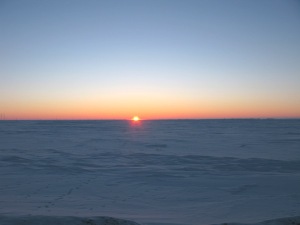Marc Frischer continues his account of the challenges of conducting research during the winter on the north coast of Alaska.
Another balmy day in Barrow, as I’m writing it is currently 46 below.
Our day started with a meeting of the full logistical support team.
The main issue of discussion was how cold it was and whether it was too cold to go out on the ice. We had entertained thoughts of setting up our ice camp (2 tents, 3 holes in the ice, generators and propane heaters) today, but by 11:00 when it was still 40 below and after much discussion, our lead ice expert and native elder Charlie Hopson declared it unsafe.
Truly I was relieved. Besides, the weather forecast is predicting warming through the week and since most of our team hasn’t arrived yet and our first actual sampling trip isn’t until Wednesday, I decided that we have the luxury of waiting a bit more.
Anyway, Zac and I still have plenty of setting-up to accomplish. So, instead of a trip on the ice, we spent most of the day continuing to unpack, setting-up our three work areas, and replacing the wiring on our submersible sampling system with Artic grade electrical wire. Turns out that regular wire easily breaks at temperatures as cold as we’re experiencing.
Later in the afternoon a few of the logistics support team took a ride out to the site to break trail, level the surface where we’ll set up the tents , and to make sure that the site was still suitable for occupation. The trip went smoothly except that they discovered a crack developing in the sea ice close to shore. If the ice was to dislodge from the shore there is a chance that our camp (and us with it) could go floating away into the Arctic Ocean. Needless to say, we are monitoring this crack very carefully. We shouldn’t forget that just because it is covered in ice, underneath the coastal Arctic ocean is still churning and can be a very treacherous place with strong and often changing water currents.
Meanwhile, Lollie and I took a little trip of our own onto the ice covered tundra to get a clear photograph of the sun’s brief appearance. The sun was noticeably higher on the horizon today compared to yesterday.
Later in the evening the next contingent of our research team arrived. From Tish Yager’s group Tara Connelly and from the Bronk group Quinn Roberts, Rachel Sipler, and Steven Baer. Now we’re only missing three. After getting them settled in we called it quits for the day retreating to our rooms to catch-up on other work and getting ready for tomorrow. Or at least that was what I was going to do until the water went out in the building that the women are staying in. Since water is delivered by truck to that building and there was nothing to be done until the morning, we quickly gathered some buckets of water from the lab so that they could at least flush the toilet a couple of times during the night. No showers I’m afraid.
Tomorrow morning we’ll meet again with our support team. Hopefully we’ll be able to set-up our camp.
marc





